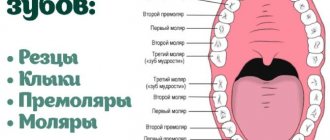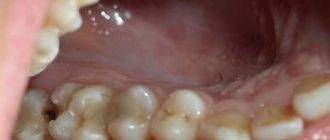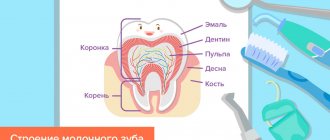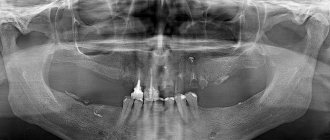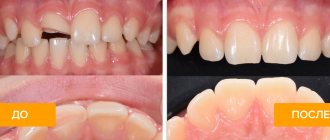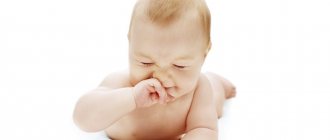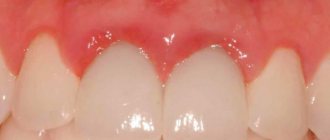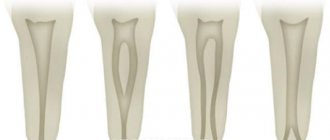Pulpitis is an inflammation of the internal structure of the tooth - the neurovascular bundle. In the vast majority of cases, this disease is caused by caries - many parents believe that it is not necessary to treat it, because baby teeth must be replaced quickly. However, this statement is incorrect, since caries, which is not addressed in time, causes tooth destruction and inflammation of the pulp.
Primary molars, especially the lower ones, are more susceptible to this. This is due to the relatively thinner enamel - the infectious process reaches the internal structures of the tooth faster. For the same reason, pulpitis in children develops much faster than in adults.
Among the causes of the disease are also injuries, including those associated with improper treatment of enamel caries, when the doctor accidentally exposes the pulp during tooth preparation.
Symptoms of pulpitis in children
Symptoms and treatment of pulpitis in children vary depending on the form and severity of the disease. Pulpitis has two forms - acute and chronic. The first is relatively less common, but the symptoms in this case are more pronounced. There are two stages of the inflammatory process:
- Serous. The pulp becomes inflamed, and the tooth canals are filled with serous fluid. The child experiences severe pain in the tooth, which intensifies at night or with exertion—chewing on the side of the causative tooth. Often there is only one episode of pain. Within a few hours, the inflammation moves into the next stage.
- Purulent. Purulent contents begin to form in the root canals of the tooth. The severity of this stage depends on several parameters: the state of the child’s immune system, the activity of microorganisms, the state of the root system of the tooth, and the age of the young patient. The pain can be tolerable if the child’s immunity functions normally, microorganisms multiply slowly, and pus escapes through the carious cavity of the tooth. However, more often there is quite pronounced pain, prolonged attacks, and the unpleasant sensations radiate to other teeth. They intensify with mechanical, temperature effects on the causative tooth; the child’s appetite worsens or he refuses food altogether. In rare cases, there is an increase in body temperature and enlarged lymph nodes.
It is worth noting that chronic pulpitis can be asymptomatic, and there are often cases of the development of an inflammatory process in a previously filled tooth. The fact is that it can be quite difficult to properly treat the carious cavity of a child’s tooth before filling it - this is due to the emotional state of the patient and the forced haste of the dentist. This leads to the fact that the filling is installed in a cavity that is not sterile or is not sufficiently dried from saliva - pathogenic microorganisms continue to multiply, penetrating deep into the tooth and causing pulpitis.
With chronic pulpitis, pain can only occur when food debris gets into the carious cavity. The gangrenous form of the disease is characterized by the appearance of pain some time after eating hot food, a feeling of fullness and heaviness in the tooth, and bad breath.
Features of treatment of different forms of periodontitis in children
Acute apical periodontitis
It is also called apical because the source of inflammation is located near the apex of the root. The acute form of the disease is accompanied by excruciating constant pain. Possible increase in temperature, symptoms of general intoxication of the body.
We recommend treating the acute form of inflammation as early as possible, before it becomes chronic.
The doctor creates an outflow of infectious fluid through the root canal, prescribes applications of anti-inflammatory ointments, bed rest and plenty of fluids.
Chronic periodontitis
The chronic form often develops for years without pronounced symptoms. It can be determined by x-ray. For treatment, a swab moistened with a 10% formaldehyde solution is inserted into the dental cavity. For multi-rooted molars, a resorcinol-formalin mixture is used, which penetrates well into all tubules.
Granulomatous periodontitis
With granulomatous periodontitis in children, “bumps” filled with granulations (dead epithelial cells) form in the oral cavity. Treatment includes 3 visits to the doctor. A month after therapy, a control x-ray is prescribed.
When should you visit a dentist?
The sensitivity of the neurovascular bundle of a tooth in a child is lower than in an adult, so the symptoms of its inflammation may be erased or absent altogether. It is important to contact a pediatric dentist when the first symptoms of caries appear - a dark spot on the tooth, or the child complains of pain. You should hurry up with your visit if:
- severe pain;
- increased pain when eating hot or cold food/drinks;
- bad breath;
- elevated body temperature;
- inflammation of the gums around the tooth;
- darkening of the enamel.
Diagnostics
Acute periodontitis is diagnosed based on complaints of pain from hot foods and when biting.
General signs of intoxication are observed (fever, changes in blood picture, headache).
The results of additional examination show:
- painless tooth probing,
- positive percussion (painful tapping on the tooth),
- positive thermal test for hot,
- electroodontodiagnostic data – more than 100 μA.
X-ray examination in children is allowed only if absolutely necessary due to the danger of radiation for the growing body.
After studying all the circumstances, the dentist decides what type of treatment - conservative or surgical - should be applied to the tooth. Any dental intervention in a child must be performed under anesthesia. It is possible to use both local and general anesthesia.
Pulpitis of a baby tooth: is it necessary to treat?
Treatment of pulpitis in children should be carried out in any case and as soon as possible. It is unacceptable to wait for a baby tooth to fall out, stopping only the symptoms. Failure to provide assistance to a child can result in serious complications - periostitis (in common parlance - gumboil), periodontitis - inflammation of the periodontal tissues. In addition, the infectious process in the neurovascular bundle of a baby tooth can spread to a permanent tooth when it erupts.
If a long time must pass before the eruption of a permanent tooth, premature destruction of a baby tooth due to pulpitis can lead to malocclusion - displacement of healthy teeth in a row, change in their position, which will require complex orthodontic treatment in the future.
If a baby tooth with pulpitis is soon to be replaced by a permanent one, the doctor may resort to extraction. In any case, this disease should not be ignored.
Causes of periodontitis
The most common cause of this disease is an infection that develops with complicated forms of caries. In children, the tissue structure is loose, there are many vessels in it, and the infection, if pulpitis is not treated in a timely manner, can spread quite quickly.
Less commonly, periodontitis can occur as a result of injury. This is very important for the front teeth. This is often possible when children begin to walk, as well as as a result of playing sports (during this period, injuries such as falling face down, being hit by various sports objects, and other similar injuries are possible). During the impact, the pulp dies and as a result, a chronic form of the disease develops.
Attention: It should be noted that the chronic form of periodontitis, in particular granulating, occurs more often in children than the acute form. The characteristics of the bone tissue of children contribute to this.
Treatment of pulp inflammation (pulpitis)
It can be difficult to extract pulp from wide root canals that have open apical foramina. When the blood vessels and nerve fibers of the pulp are cut off, the periodontium is injured and a slight hemorrhage occurs, causing inflammation.
When treating a tooth with medication, medications easily penetrate the periodontium, irritating or even burning it.
Filling wide canals is also fraught with complications:
- when filling root canals, it is possible to push their infected contents into the periodontium,
- It is extremely difficult for a doctor to insert a pin or filling material strictly to the apex of a root shortened by physiological processes, without going beyond it into the periodontium.
Overbite
Periodontal inflammation can be caused by excessive stress on the tooth, resulting from placing a filling that is too high when treating the affected tooth itself or the opposite one on the other jaw - increased pressure causes stretching of the ligaments that hold the tooth in the socket.
Wearing orthodontic appliances often also causes overload of the periodontium, so correcting the bite involves frequent visits to the dental office for control examinations.
Too early teething can also cause overload of their fragile roots and periodontium.
Injuries
The periodontal tissues cannot withstand excessive pressure on the tooth from traumatic agents. Acute injury occurs as a result of a single impact on the tooth during a fall, bruise, outdoor games, fight, or traffic accident.
Chronic injury occurs when you have bad habits:
- chew pencils, seeds, nuts,
- use teeth to open bottles, bite branches, untie tight knots.
Lymphogenous infection
In case of a purulent inflammatory process in the oral cavity or a severe general disease, the infection can penetrate into the periodontium through the lymphatic or blood vessels. The loose, unformed bone tissue of children's jaws facilitates the rapid spread of pathogenic microorganisms through it.
Treatment methods for pulpitis
The tactics of a pediatric dentist depend on the condition of the child’s tooth and dental system, the severity of his condition, and whether there are concomitant diseases of the oral cavity. If the pulpitis is very severe and there is a risk of a threat to its health, the tooth must be removed. However, in the vast majority of cases, it is possible to keep the tooth permanent until its natural replacement, since removal can lead to disruption of the bite or the position of the remaining healthy teeth in the row.
Traditional treatment of dental pulpitis in a child consists of devital amputation of the pulp and is carried out in several visits. The stages of treatment of pulpitis in children are presented as follows:
- The doctor opens the tooth cavity, removes carious tissue, and applies a paste to devitalize the pulp. It is designed to “kill” the neurovascular bundle and eliminate pain. If the paste contains arsenic, it is used for a period of 1-2 days; if an arsenic-free product is used, it is used for at least 7 days.v
- The second visit involves placing a special mixture into the canals for tissue mummification - a resorcinol-formalin mixture is used.
- The third visit is to fill the diseased tooth.
This method is practiced much less frequently today, since there is a possibility that the infectious process will persist in unsealed tooth canals - mummification of the pulp involves its “drying out” and the formation of voids in which pathogenic bacteria continue to multiply.
The modern approach to the treatment of pulpitis of primary teeth in children is extirpation - complete removal of the inflamed pulp. This can be done with or without prior killing or devitalization of the pulp. In many cases, devitalization is more preferable, since it relieves the child of any unpleasant sensations during the removal of the neurovascular bundle.
After the tooth canals are freed from pulp and carefully processed, the doctor fills them with an anti-inflammatory paste - it tends to dissolve along with the roots during the natural change of teeth to permanent ones. For this purpose, zinc eugenol paste is often used. This method of treatment is comparatively more effective, and if the canals are treated with the utmost care, the infection will not reactivate. Other modern methods of treating pulpitis in children include vital amputation. It consists of preserving the viability of part of the pulp - the upper part of the nerve is removed under local anesthesia, and a medicine with an antibacterial and anti-inflammatory effect is applied to the remaining root pulp. The drug closes the lower part of the neurovascular bundle without affecting its viability, and the tooth is subsequently filled.
Conservative methods
At the slightest opportunity to save the tooth, gentle conservative treatment is used. Endodontic treatment involves repeated root canal treatment.
First visit
- Anesthesia.
- Cleaning out the carious cavity with a drill, removing softened dentin (bone dental tissue).
- Expansion of the root canal mouth using a special hand instrument.
- Removal of the “dead” pulp – the neurovascular bundle inside the cavity.
- Expansion of the canal and its mechanical cleaning.
- Rinsing the cavity with an antiseptic solution - sodium hypochlorite or chlorhexidine bigluconate.
- Opened apical (root) openings for the outflow of exudate.
- Filling the canal with an anti-inflammatory drug: for permanent teeth - a paste based on calcium hydroxide, for temporary teeth - an oil-based paste.
The doctor leaves the tooth in this state for some time - from 2 to 10 days. In the intermediate period, rinsing the mouth with antiseptic solutions (Chlorhexidine, Miramistin) is prescribed, and less often, taking antibiotics.
Treatment of a tooth with dead pulp
Second visit
- Mechanical cleaning of the canal, removal of medication.
- Washing with an antiseptic.
- Installation of a permanent filling - hermetically closing the cavity with gutta-percha, hydroxyapol or other material.
Physiotherapy
Physiotherapeutic methods are used as an aid in the fight against inflammation. These are inexpensive and painless procedures, children tolerate them well:
- electrophoresis of antiseptics - enhancing the antiseptic effect using pulsed current;
- phonophoresis – introduction of an antiseptic under the influence of ultrasound;
- laser therapy – the laser beam sterilizes the root canals and has a direct bactericidal effect.
Laser therapy
Treatment of pulpitis of teeth with unformed roots
The root system of a baby tooth is formed over a long period of time after eruption, so there are often situations when caries begins to form on a tooth whose roots have not yet closed the apex. This leads to some treatment difficulties:
- short roots and wide channels;
- the upper part of the root is the “growth” zone, injury to which is an obstacle to root formation;
- the likelihood of infection of the permanent tooth germ;
Treatment of pulpitis of teeth with immature roots in children requires special care. The doctor must carefully monitor that the filling material is not carried beyond the expansion of the root apex. It is worth noting that complete removal of the pulp and treatment of the canals is impossible - the optimal solution here is vital and devital extirpation. Pulp amputation may also be used. The biological method, which consists in preserving a viable pulp and relieving inflammation, is also practiced quite often. Its essence is to prepare the tooth, apply a medicinal paste with calcium hydroxide, after which the tooth is filled with temporary material. A few days later, if there are no complications and the unpleasant symptoms disappear, the doctor installs a permanent filling.
Principles of treatment of teeth with formed roots
The tactics for treating chronic periodontitis are identical to the approach for treating temporary teeth. If the following conditions are met, it is possible to cope with the disease in one visit:
- there is no gangrenous decay with a putrid odor in the canal;
- there are no granulations grown into the canal;
- there was no exacerbation of such diseases in the anamnesis;
- it is possible to qualitatively process the canal in one visit and dry it;
- the child is somatically healthy and does not take antibiotics, cytostatics, corticosteroids or other immunosuppressive drugs.
In this case, during one visit, the root canal is treated instrumentally and medicinally, obturation is performed with a permanent root filling, and then the crown part is restored. It is much more common to practice treatment in several stages.
On the first visit, the following manipulations are performed:
- necrotomy, formation of a carious cavity;
- opening the canal and removing putride masses from it using a pulp extractor or several - with a very wide canal;
- removal of granulations grown into the canal with injection anesthesia or short-term treatment of granulations with special preparations, for example camphorophenol (very carefully so as not to burn the mucous membrane);
- instrumental treatment of the canal, washing and drying;
- administration of a medication with an antiseptic effect on the turunda or in the form of a paste;
- isolation with an airtight bandage for temporary obturation of the carious cavity.
The medicine is left on average for 1-7 days, after which permanent obturation is performed - subject to the conditions of readiness of the root canal. Obturation is carried out with a sealer with gutta-percha, after which X-ray control is necessary, and only then restoration of the crown.
How to prepare a child for treatment?
Treatment of pulpitis of primary teeth in children is a rather complex task, so it’s great if the child is already familiar with the dentist’s chair. The first visit should be preventative - to familiarize yourself with the office environment, the doctor, and the instruments.
Also, the task of parents is to psychologically prepare the child. Required:
- talk to your child about doctors in a positive way - tell them that the dentist treats teeth and makes sure they don’t hurt;
- play dentist with toys and other family members;
- avoid mentioning pain or unclear, scary terms;
- do not deceive the child - explain that dental treatment may not be very pleasant, but it will not last long and the tooth will no longer hurt;
- remain calm, act gently but confidently if the child resists treatment;
- choose a suitable time for visiting - it is better in the morning, when the baby is alert and active;
- take a toy with you to calm the child;
- give the doctor the opportunity to establish contact with the small patient - do not rush him;
- Do not scare the child under any circumstances, do not threaten, do not blackmail.
If the situation cannot be controlled completely, you will have to reschedule the appointment for another day. However, the disease should not be ignored - treatment of pulpitis of baby teeth in children must be carried out one way or another. In special cases, treatment under general anesthesia may be considered, but this should be discussed with your doctor.
Prevention
To prevent periodontitis from developing in a child’s teeth, it is necessary:
- Strengthen the child's health by maintaining his immunity at a high level.
- From a toddler age, teach children to take care of their oral cavity independently.
- Bring your child to the dentist at least twice a year for a preventive examination.
Periodontitis is the main reason for tooth extraction at any age. In order for teeth to serve a person well throughout their entire life, it is necessary to instill in the child the principles of a healthy lifestyle and careful treatment of teeth from early childhood.
Sources
- https://asepta.ru/spravochnik/zubi/chem-opasen-periodontit-molochnogo-zuba-i-kak-izbezhat-vstrechi-s-nim/
- https://rvdku.ru/stomatologiya/chem-opasen-periodontit-u-detej-i-kak-ego-vylechit
- https://TopDent.ru/articles/periodontit-u-detey.html
- https://anZub.ru/lechenie-zubov/periodontit-u-detejj/
- https://linesmile.ru/info/detskaya-stomatologiya/periodontit-lechenie/
- https://www.duncan-medi.ru/lechenie-zubov-detyam/lechenie-periodontita
- https://MyDentist.ru/detskaya-stomatologiya/lechenie-periodontita/
- https://MikDent.ru/rebenok/deti-desna/periodontit-molochnogo-zuba.html
Possible complications of treatment of pulpitis in children
Child anxiety is the main difficulty faced by pediatric dentists. Due to the emotional state of the patient, the specialist has to rush or fails to perform the manipulation carefully, which may result in the following complications:
- the paste is not applied to the nerve - this leads to the fact that the pain does not subside, and the procedure must be repeated again;
- burn of the gums by the paste due to its close location to the tooth;
- bleeding when processing unformed roots;
- perforation of the root of a baby tooth;
- breakage of instruments in the root canal.
You can avoid possible complications or minimize the likelihood of problems arising by normalizing the child’s psychological state and contacting an experienced, qualified doctor.
Making a clinical diagnosis of pulp pathology in permanent teeth in children
A key factor in formulating an appropriate treatment plan is determining the nature and extent of pulp inflammation. However, the clinician should always be aware that pulp status and clinical signs and symptoms are not always consistent.
Medical and dental history
Medical and dental histories should always be accurately documented and a thorough clinical and radiological examination should be performed. In the event of injury, it is necessary to ask both the patient and the parents about the time and circumstances of the gender
Prevention of pulpitis in children
Treatment of pulpitis in permanent teeth in children, as well as their “predecessors” - baby teeth - is a rather complex procedure that may require several visits to the doctor. Preventing a disease is easier than treating it - all you need to do is pay attention to hygiene procedures and teach your child how to brush their teeth correctly from a very early age.
It is also important to monitor the child’s diet - strengthen the enamel with solid foods (carrots, apples, etc.), provide a balanced diet to saturate bone tissue with minerals. It is better to limit sweets and give only water at night. Prevention of caries is the basis for preventing its complications, including pulpitis.
Symptoms
Pediatric periodontitis has the same clinical forms as in adults. The following classification of periodontitis in children is used:
- Acute - serous and purulent - manifested by pain when biting on a tooth and when eating hot food. Acute periodontitis in children can occur during the treatment of pulpitis and during tooth trauma, and is often accompanied by inflammation of the periosteum - periostitis. The general condition of the child is sharply disturbed due to intoxication: sleep and appetite are disturbed, headache appears, temperature rises, ESR and leukocytosis accelerate. In weakened children, phlegmon or osteomyelitis develops after a couple of days.
- Chronic periodontitis in children - granulating, granulomatous and fibrous - is asymptomatic. Read more about fibrous periodontitis→
- Exacerbation of chronic periodontitis . This form is not recognized by the International Classification of Diseases, but is convenient in practical work for characterizing the clinical manifestations of the disease.
Acute periodontitis is rare, because milk and newly emerged permanent teeth have loose dentin and are quickly destroyed, providing a good drainage of inflammatory exudate from under the roots of the tooth.
This is interesting: The best means for restoring and strengthening tooth enamel
Of the latent forms, chronic granulating periodontitis is most often observed. With it, the infection quickly spreads through the bone cells and breaks out with the formation of a purulent fistula on the gum. This picture is typical for chronic periodontitis of primary teeth.
Granulomatous periodontitis is characterized by the presence of an isolated abscess at the apex of the root, delimited from the bone by a soft shell. Such a dormant lesion, a granuloma, can grow unnoticed for a long time, turning into a cyst.
Chronic fibrous periodontitis rarely affects primary and permanent teeth with formed roots; it is asymptomatic, often in a completely healthy-looking, undamaged tooth.
Features of chronic periodontitis in children:
- It can occur with a closed pulp chamber and with shallow carious lesions. Read more about initial caries→
- Occurring during the period of tooth formation, it leads to the cessation of its growth.
- Inflammation at the root of a baby tooth can affect the development of the follicle of a permanent tooth.
